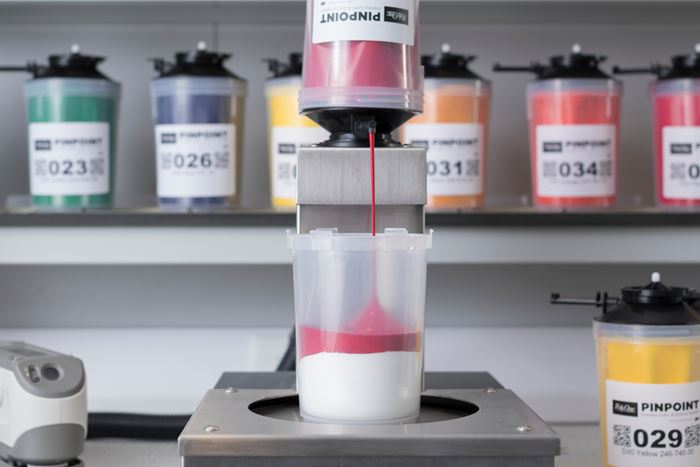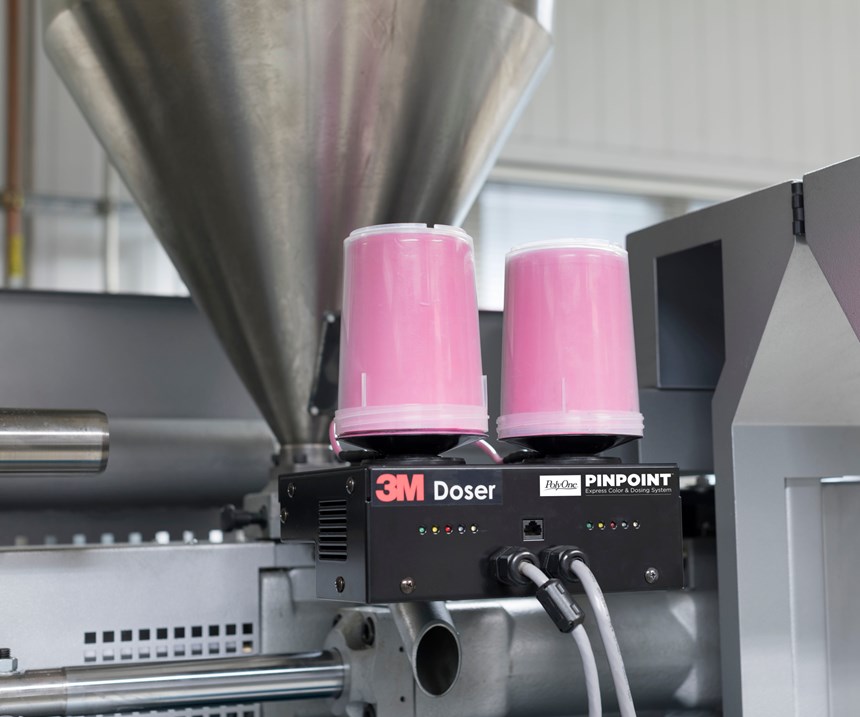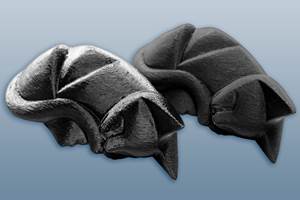Colorants: New System Allows Custom Liquid-Color Matching by Molders
PolyOne and 3M collaborate on quick recipe generation and mixing/dosing of liquid colors for in-house color matching by short-run injection molders.
A new liquid-color mixing and dispensing system is designed to permit efficient in-house color matching by injection molders who perform short runs with short lead times and handle dozens of colors. The Pinpoint system was developed by PolyOne in collaboration with 3M. It combines proprietary software and liquid-colorant technology from PolyOne’s ColorMatrix Select system with dispensing and dosing equipment from 3M. According to Will Nordloh, general manager of ColorMatrix, “Pinpoint enables short-run injection molders to make a step change in their ability to serve customers by significantly reducing the time needed to design and create colors. The system also helps reduce operating costs by eliminating the need to carry excess or expired colorant inventory.”
Pinpoint made its debut at last month’s MD&M East show in N.Y.C., where it was showed off by an early adopter of the system, Protolabs, a custom maker of metal and plastic parts for rapid prototyping and on-demand production. Jeff Schipper, the company’s director of Special Operations, agrees that Pinpoint is a “game changer” for cosmetic applications such as medical-equipment housings and consumer electronics. He says customers can supply a Pantone color number or a physical sample of a color to be matched. The Pantone number or data from a spectrophotometer scan of the sample is fed into the Pinpoint software to generate a starting recipe of ColorMatrix liquid colors to be blended. (Schipper compared this to blending paints at a hardware store.) Additional data entered into the recipe software includes the plastic resin to be used and any special application data such as suitability for medical use or outdoor UV exposure. The user also indicates whether the recipe should be optimized for closest match or lowest cost. A typical recipe can utilize four or five different base colorants, but can include as many as eight to 10, Schipper says.
The starting recipe is fed into the Pinpoint dispenser. Containers of around 1 qt capacity for single colorants that make up the recipe are connected to a feed tube and locked into the device. The required amount of each colorant is dispensed one at a time into a container for the final color. The amount dispensed is checked gravimetrically by weighing the receiving container. Schipper noted that a barcode scan of each ingredient color is required by the system as a QC check to ensure that only the correct colorants are blended. The completed blend is then placed in a shaker to mix the components. Finally, the container with the blended colors is placed in a Pinpoint metering pump on the injection machine to produce colored parts. The device holds two containers; when one empties, the system automatically switches to the second so the first can be replaced without interrupting production.
Schipper says its Pinpoint system is currently available for 13 resins, including ABS, PC/ABS, PP, HDPE, LDPE and LLDPE. Protolabs can supply a sample color chip to customers within three days of receiving the Pantone number or color sample. Schipper says customers accept the first sample in the “vast majority” of cases so far, though Protolabs offers up to three iterations if necessary. Protolabs guarantees a match within a Delta E of 3, “though we’re usually within 1 to 1.5,” Schipper says. (He notes that the human eye can detect color differences at a Delta of a little over 2.) Schipper also notes that Protolabs has used the resulting liquid colorants for molding runs as long as three days without problems. “With development cycles shrinking to meet the market demand for increased customization, this is yet another tool to help our customers accelerate product launches and streamline supply chains,” says Joel Matthews, Protolabs global product manager.
Related Content
Additives Boast Sustainability Without Sacrificing Performance
Sustainability continues to dominate new additives technology, but upping performance is also evident. Most of the new additives have been targeted to commodity resins and particularly polyolefins.
Read MoreMasterbatches Reduce Gloss in PLA and PETG 3D Printed Products
Insight Polymers & Compounding’s two low-gloss additive masterbatches shown to boost appearance of 3D printed objects.
Read MoreTosaf’s Investments in North America Result in 40% Increase in Production Capacity
Backed by a global presence, Tosaf provides localized additive and color solutions, and services for the plastic industry in North America.
Read MoreIntrinsic Viscosity Enhancer for rPET and PET Food-Contact Applications
Nexam’s Nexamite MO2100 rebuilds molecular weight and increases IV to enable upcycling of rPET.
Read MoreRead Next
Lead the Conversation, Change the Conversation
Coverage of single-use plastics can be both misleading and demoralizing. Here are 10 tips for changing the perception of the plastics industry at your company and in your community.
Read MoreBeyond Prototypes: 8 Ways the Plastics Industry Is Using 3D Printing
Plastics processors are finding applications for 3D printing around the plant and across the supply chain. Here are 8 examples to look for at NPE2024.
Read More






















